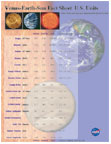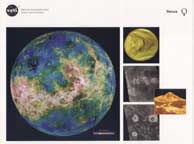|
Some materials require the Flash 6 plug-in

|
 |
Please
register to get a packet of support materials, available in November
2003.
Sun-Earth Day Kit

|
Venus Transit Folder
The folder features a view of Earth, Venus and the Sun to illustrate the transit geometry,
along with a sketch that illustrates the manner in which they interact with the solar wind.
An archival, telescopic photo of the 1882 transit and an etching of children viewing the transit
appear on the back of the folder. The inside material includes quotes from major newspapers about
the 1882 transit, and a detailed classroom activity describing the geometric properties
of 'triangulation' and 'parallax'.
|

|
Venus Transit Poster (SECEF/SOHO)
Aimed at middle school levels, the color poster describes when the transit will take
place and how to view it. Users will learn about the science, math, history, and cultural
aspects related to the recurring celestial event. There is a lesson on the showing the scale of the solar system.
Download
Poster: pdf format, 5.1M file size, 25.5" w x 22" h poster size
|

|
Venus Transit Flyer - Featured Activities for the Transit of Venus (SECEF)
This flyer summarizes the event and programs for participation, and lists some of the activities for
educators. See
http://sunearthday.nasa.gov/.
|

|
The Dynamic Sun CD-ROM (SOHO)
This CD contains educational, multimedia presentations with images and many movie clips
of the Sun with teacher's guides for use in elementary, middle, and high schools, respectively.
Additional resources include a slide show, an interactive poster, frequently
asked questions, and more. Version 5 contains files in both English and Spanish.
See
http://sohowww.nascom.nasa.gov/explore/materials/DSweb/DSweb1.htm.
|

|
how big is our universe? Booklet (SEU)
This 16-page color booklet puts the Transit of Venus event into cosmic perspective.
The determination of the true distance of the sun is the first step in answering one
of the greatest questions humanity can ask: How big is our universe? Page by page, using
beautiful photographs and straight-forward methods and ideas, the booklet leads the
reader out of the Solar System and into the realm of the stars, the galaxies, and
finally the vast panorama of the observable universe. Along the way we ponder our
own place in space and time.
See
http://cfa-www.harvard.edu/seuforum/howfar/index.html
and download in pdf format (3.5 MB)
|

|
"Kepler: A Search For Terrestrial Planets" Fact Sheet (Kepler)
This fact sheet describes the Kepler spacecraft and its search for potentially life-supporting planets around other stars.
Using the transit method and observations one can tell the planet size, the diameter of the
planet's orbit, and estimate the planet's temperature, key qualities to determine possibilities for
life on the planet. For more information, a transit animation, and a do-it-yourself paper model of
the Kepler spacecraft, see
http://www.kepler.arc.nasa.gov.
See also the Kepler public education web site at
http://www.lawrencehallofscience.org/kepler/.
|

|
Planetary Fact Sheet on Venus and Earth (NSSDC)
This fact sheet provides a comparison between Venus, the Earth, and the Sun, showing the actual mass,
diameter, density, gravity, etc. of each and the ratios normalized to the Earth. The
numbers are given in both metric and U.S. units. For a copy in html and PDF versions
visit
http://nssdc.gsfc.nasa.gov/planetary/factsheet/ves.html
|

|
Venus Lithograph (SSE)
This mini poster contains images, facts and research results of Venus from various spacecraft missions since 1962.
|

|
"Venus and Earth - The mismatched Twins" Activity Sheet (IMAGE)
This fact sheet talks about magnetic fields and how the planets react to solar wind.
One page focuses on magnetic reversal. There are also two science and math activities
related to the transit of Venus and the Earth's changing magnetism. For more information,
see
http://image.gsfc.nasa.gov/poetry/venus/Vyears.html
and
http://image.gsfc.nasa.gov/poetry/venus/MagRev.html
|

|
Voyager: The Interstellar Mission Bookmark (Voyager)
A color bookmark with images of outer planets and the unique functions of the mission.
See
http://voyager.jpl.nasa.gov/.
|

|
What Causes Storms from the Sun" Brochure (Polar)
This colorful tri-fold brochure describes the causes, dynamics, frequency, observation, and impact of coronal mass ejections
with recent NASA images and web links.
Download a pdf version of "What Causes Storms from the Sun"
(high version) 7.5M
|

|
Space Science Education Resource Directory Card (NASA Office of Space Science)
The directory is a database of NASA space science education resources for K-12 teachers and students, including lesson plans, educator guides, student activities, and websites.
See http://teachspacescience.org.
|
|

